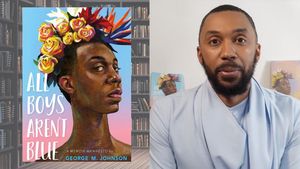When, last weekend, The New York Timespublished a special issue of T magazine reflecting on the years 1981-1983, it was easy to feel both moved and impressed by the attention paid to the paper's infamous disregard for the biggest story of the era: AIDS. In commissioning six LGBTQ editors to address the paper's notorious homophobia the Times appeared to be engaged in a reckoning with its past failings. Like the paper's project to retroactively add obituaries for women--from Charlotte Bronte and Nella Larsen to Diane Arbus--who had been overlooked by the paper in their day, it felt both appropriate and significant. Here, at last, was the paper of record putting on the record one of the most egregious examples of moral dereliction. As Kurt Soller, articles editor at the magazine, pointed out in an introduction, for too many years the paper gave the disease scant attention, only putting it on the front page in 1983, two years after symptoms were first reported.
Related | 'Portrait of the AIDS Generation' Spotlights Survivors & Community
We live, of course, in the age of the mea culpa, but when the apology comes unprompted by a sudden scandal or revelation, the contrition feels genuine, not simply damage control. Much like the rest of society, the Times has evolved and appears ready, even eager, to atone for the past. "One of the reason this is coming up now in this moment is that we're all examining what identity means, and reexamining what power means, and reexamining how we present those conflicts on the page," Hanya Yanagihara, the editor-in-chief of T, and the celebrated author of A Little Life explained during a phone conversation. Since the paper today is not the paper of yesteryear, the exercise of addressing its past failings is, of course, easier to do. Of the six writers, only Adam Nagourney is old enough to have experienced the homophobia of the '80s as a working journalist. Yanagihara was still in the single digits when AIDS made the Times's front page. Like women of color who have assumed editor-in-chief roles elsewhere--Lydia Polgreen at HuffPost, and Radhika Jones at Vanity Fair--her tenure represents a more vigorously inclusive perspective.
In a percipient gesture, Larry Kramer was photographed for one of seven special covers, a nod to the writer's decades-long ire with the Times for its homophobia. In his searing play, The Normal Heart, Kramer satirized the paper's inaction in the figure of closeted NYT styles writer, Felix Turner. That was in 1985, many years before the paper began to reevaluate its posture on LGBTQ issues. I still remember the editorial board's decision to publish same-sex wedding vows in 2002, and feeling acknowledged in ways that were deeply validating. It's hard to believe that such a small step could feel revolutionary, but it did, and it was.
Related | 26 Films About HIV/AIDS Everyone Should Watch
What, then, might have been achieved had the Times attended to HIV/AIDS with the diligence it later paid to marriage equality? In an email, the veteran AIDS activist Peter Staley pointed out that an outbreak of Legionnaire's disease in 1976 elicited 62 stories from the Times in the space of two months, of which 11 made the front page. "Legionnaire's killed 29 people. AIDS killed 6,000 people before the Times gave it front page coverage," he wrote. "Imagine if the Times had put AIDS on the front page 11 times in 1981. How would that have changed the course of the epidemic? How many lives would have been saved?" The writers of the pieces do not duck the question, although Staley considers the exercise more self-serving than remorseful. Natalie Kitroeff writes how the newsroom culture under then-editor A.M. "Abe" Rosenthal, "often forced its L.G.B.T. journalists to choose between their career ambitions and their desire to have an openly queer life."
As with other public conversations around exclusion and erasure, Yanagihara considers the exercise in T as a starting point, not an endgame. To learn from your failings, she knows, you need first acknowledge them. "If you're going to be aware of your place in the cultural firmament, and you're going to call yourself the writer of the first draft of history, which is really how journalists here are trained to think, I think rightly, then it does mean reckoning, retroactively, with mistakes," she says.
Cover or no cover, Kramer, is not ready to give the paper a pass just yet. Like Staley, he took exception to the ways in which some of the pieces appear to deflect criticism--for instance, by attributing the scant attention to AIDS to an "overtaxed" science desk. "These excuses were sort of namby pamby," he said. "Anyway, it's hard to accept them when you realize how many millions are dead from a plague that The Times wouldn't warn the world about." It's a salutary reminder that for those who lived through the plague--the witnesses who fought with every ounce of their being to save the lives of their friends and lovers, the Times mea culpa is too little, too late. The people who most need to hear it are all dead.

























































